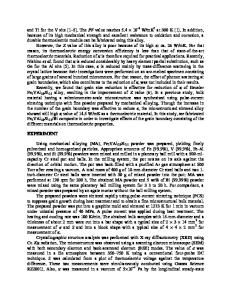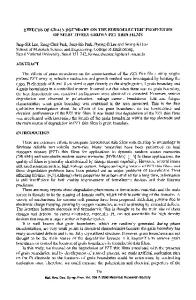Effect of 3d Transition Metals Addition on the Ferroelectric Properties in Bi Ferrite Thin Films
- PDF / 1,257,439 Bytes
- 7 Pages / 612 x 792 pts (letter) Page_size
- 4 Downloads / 252 Views
1034-K03-11
Effect of 3d Transition Metals Addition on the Ferroelectric Properties in Bi Ferrite Thin Films Hiroshi Naganuma, Jun Miura, and Soichiro Okamura Tokyo University of Science, 1-3 Kagurazaka, Shinjuku-ku, Tokyo, 162-8601, Japan ABSTRACT Pure and 5 at%-Cr, Mn, Co, Ni or Cu added BiFeO3 films were fabricated on 111-textured Pt/Ti/SiO2/Si(100) substrates by chemical solution deposition followed by annealing at 773K, and their crystal structure, microstructure and electrical properties were investigated. Cr and Ni are not attractive as additives because the Cr added film was crystallized into an undesirable phase and the Ni added film was amorphous and/or low crystallinity. The Co added film showed unsaturated hysteresis loops due to high coercive field. The Cu addition improved the shape of hysteresis loops as well as the Mn addition which suggested the decrease of leakage current at high applied field although the surface morphologies of these films were quite different.
INTRODUCTION Bi ferrite (BiFeO3) has attracted much interest for novel electronic device applications because of the coexistent of antiferromagnetism and ferroelectricity [1-3]. It is also attractive just as a ferroelectric material because of large spontaneous polarization predicted to 90 – 100 µC/cm2 by first-principle calculation [4]. However, the ferroelectric properties are frequently spoiled due to high leakage current density [5, 6]. Therefore, in order to suppress the leakage current at room temperature, many additives have been examined for the Bi ferrite films. In fact, some of additives such as Ti, [7, 8] Cr [8, 9], Mn [10, 11] and La [5, 13] have reduced the leakage current, although the degree of suppression of leakage current was different in these reports. In general, the leakage current properties of Bi ferrite films are affected by preparation processes and conditions [2, 5, 6, 14]. Therefore, it is difficult to judge which additives is the most attractive to reduce the leakage current of Bi ferrite films from there reports in which different preparation techniques were utilized. Our aim in present study is fabricating Bi ferrite films with adding Cr, Mn, Co, Ni and Cu at 5at.% by chemical solution deposition (CSD) method and evaluating not only leakage current density and ferroelectricity but also film structures.
EXPERIMENTAL PROCEDURE Pure and 5 at%-Cr, Mn, Co, Ni and Cu added BiFeO3 films were fabricated on 111-textured Pt/Ti/SiO2/Si(100) substrates by CSD method. Annealing for crystallization was carried out at 773 K in air for 10 min using a rapid thermal annealing system. After the annealing, top Pt electrodes were deposited at room temperature by rf magnetron sputtering. The thickness of the BiFeO3 films was approximately 200 nm. Film structure was confirmed by conventional θ/2θ x-ray diffraction (XRD) using Cu-Kα radiation. The surface morphology of the films was observed by atomic force microscopy (AFM). Ferroelectric properties of the BiFeO3 films were measured at room temperature using a triangular waveform
Data Loading...










